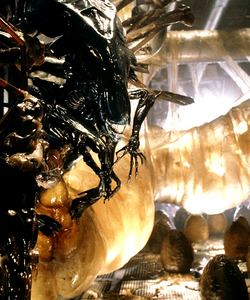
The First Acheron Queen atop her ovipositor.
The ovipositor,[1] also known as the ovithorax[2] and more commonly referred to as the Egg sac,[1] is the part of a Xenomorph Queen that creates and then lays Eggs. While a Queen is perfectly capable of surviving without an ovipositor, she cannot produce more Eggs in this state.
Overview[]
A Queen's ovipositor is enormous, easily dwarfing the size of her body. Typically stretching for many tens of feet, the structure is analogous to the large egg-producing abdomen of queen termites. Eggs are produced inside the ovipositor constantly in a fashion similar to a mass production line, first forming at the base of the sac, where it connects to the Queen herself and developing as they move towards the rear.[3] Finally, the developed Eggs are laid by a prehensile, trunk-like opening at the ovipositor's tip. Eggs are produced continuously and at a rapid rate; a laying Queen is capable of producing up to 15 Eggs per hour.[1] If a Queen is inactive (with regards to laying) for an extended period, the first few Eggs she lays upon reviving are liable to be malformed and infertile. However, in very short order, fertile Eggs will be created.[4]
Unlike the Queen herself, who is protected by a resilient mesoskeleton capable of repelling moderate forms of gunfire,[5] the ovipositor is made of soft, penetrable tissue that is comparatively easily damaged.[1] Moreover, it is disconnected from the Queen's circulatory system, meaning it does not contain any acid blood.[1] This makes it relatively vulnerable in comparison to most aspects of Xenomorph biology — somewhat surprising considering its importance — and leaves a laying Queen entirely dependant on her Drones for protection.
Queens are able to remain mobile during the early stages of ovipositor development,[6] but owing to the immense size and weight of a producing sac, they soon become unable to move. As it grows, the ovipositor is typically suspended from the roof of the Hive by resin "straps". The Queen's immobility leaves her doubly dependant on her brood for defense and care. Other Xenomorphs also tend to the Eggs once they are laid, moving them from beneath the ovipositor to "nursery" areas within the Hive. Notably, despite the ovipositor constituting a huge proportion of the Queen's overall mass, destroying it is not fatal to the Queen herself.[3] In fact, in an emergency, the Queen can voluntarily separate from her ovipositor to allow her to move, although this process is apparently quite painful for her.[3] While she cannot subsequently reattach the discarded sac, she can grow a new one fairly quickly.[2]
Trivia[]
- In Alien Resurrection, the Cloned Queen sheds her ovipositor and replaces it with a womb-like appendage that she uses to give live birth to a new kind of Alien, the Newborn. This alternate reproduction method was brought about as a result of genetic cross-contamination resulting from the cloning process used to create the Queen's original host, Ripley 8.
References[]
- ↑ 1.0 1.1 1.2 1.3 1.4 Weyland-Yutani Archives (2008), 20th Century Fox [Blu-ray]
- ↑ 2.0 2.1 Aliens vs. Predator, Microsoft Windows version, Rebellion, 2010.
- ↑ 3.0 3.1 3.2 James Cameron (writer and director). Aliens (1986), 20th Century Fox [DVD].
- ↑ Marc Cerasini. Alien vs. Predator, p. 133 (2004), HarperEntertainment.
- ↑ Aliens versus Predator 2, Microsoft Windows version, Monolith Productions, 2001.
- ↑ Tim Lebbon. Alien: Out of the Shadows, p. 220 (2014), Titan Books.
